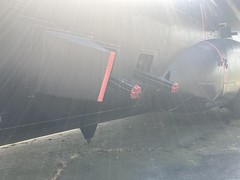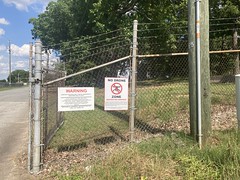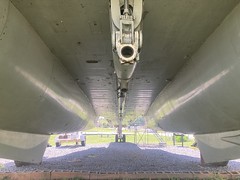It's a stretch to call this "Outdoor Adventure" but proper outdoor adventure has been in short supply lately, so I'm going with it.
I was off the bike for a while, letting all of my parts heal, and the whole time I kept looking over at my mountain bike, with absolutely no interest in fixing it, much less riding it. The road bike though, kept looking better and better. When I was finally healed up enough to even consider putting any weight on the saddle, I first did so on the road bike. While I wouldn't describe it as comfortable, it wasn't explicitly painful, so I went for a couple of rides to feel things out.
The first half hour of the first ride felt like when you cut your fingernails too short and drag them across fabric. Then, I guess, my nerve endings were like "eh..." and I felt a lot better. A couple of those later, and I was feeling like attempting some of my old-school road routes from 10 years ago, up through Marietta.
Saturday morning, I got up at a reasonable hour, spun down Cooper Lake, crawled the hills over to Atlanta Road, and headed north. I could tell that it was going to be a long, probably uncomfortable day, but I was taking it easy and trying to enjoy the moments. Somewhere over by Lockheed I remembered the museum!
There's a lot over there with a dozen or more restored, or partially restored airplanes. I'd ridden (and driven) past it hundreds of times, each time thinking: "I should go check that out..." and never did. I was always pressed for time, going somewhere else, or putting in work, and just never had a good opportunity. But, that day, everything was just right, so I stopped in.
I followed the signs and proceeded to Checkpoint Alpha, which turned out to be a pop-up tent with about 6 or 8 folks hanging out in folding chairs underneath it. I'm not sure they immediately understood that I wanted the tour. It's probably not everyday that a guy shows up on a bike, in lycra, drenched, asking about the planes. They were happy to take my $5 though, and instructed me to head over towards the C-141.

Lockheed produced and maintained C-141s from the '50s through the '90s. It wasn't the biggest plane out there, but it was big enough, and cheap enough to fly to hit the sweet spot for a lot of operations. It was only cancelled when the Boeing C-17 (and associated politics) hit the scene. I'd been inside of one once before at an air show in Texas, and I'd seen pieces get added to this one, little by little, over the years, but I'd never been up close to it.
When I first saw it, it was missing the engines and control surfaces, but they were added a few years back.

And more recently than that, it got a new paint job.

The tour guide met me at the back end of the plane. He was a Loadmaster on C-141s for like 30 years, and warned me ahead of time that he would probably give me way more information that I ever wanted, so let him know if he was rambling on. He clearly underestimated how ready I was to geek out over his plane.
The tour he gave me was about as top-notch as I could have imagined. He was a super nice guy, he had detailed answers to all of my questions, and usually a quick little story go to along with each. IDK how long we were in there, but I do know that another group of folks came and left while we were still talking. Seriously, if you're into planes, and in the ATL, you should get the tour. I kind-of don't want to spoil it by giving away too much info, so here's the abbreviated version...
The C-141 revolutionized air transport in much the same way container ships/trains/trucks did. This pallet...

...could be loaded 9 feet high and a bunch of them could be staged.
Then some strong guys could push them up into the back of the plan on these wheeled floor tracks:

You could load an entire plane in just under an hour. They shipped everything, worldwide: "Beans, bullets, and bandages." That same pallet was used on the C-5 and later C-17, and is still in use. By comparison, the C-130 and other previous cargo planes had to be loaded more ad-hoc.
You couldn't fit a tank in a C-141 (that required a C-5, which could fit 2 or 3) but you could fit 3 hueys in one, as well as pretty much any non-tank vehicle.
They also transported troops. These were the standard seats:

There was a row of them down each side of the plane, and they could fold up out of the way when carrying cargo. Commercial-airline style seats could also be fitted, but they were only used when transporting lots of troops or VIPs, or whatever.
Apparently some planes were pressurized and could fly above 30,000 feet at around 300 mph, but others weren't, had to fly under 10,000 feet, got kicked around by turbulence, and had to keep their speed down to about 170 mph. Those were long, long flights.
The C-141 was also the first military cargo plane with a bathroom:

Prior to the bathroom, they used a bucket, and it was tradition for whoever first used it to empty it, so guys would try to hold it as long as possible as a bit of a game.
The cockpit was amazing!




I got to sit in the pilot's seat. It's tricky to get into. They specifically tell you how to do it - what to grab onto, and how to not bump your head.
I still bumped my head.
There are various extra seats in the cockpit. If they're only transporting cargo, the Loadmaster can sit in one of them throughout the flight. If there's even one person in the cargo area though, the Loadmaster has to spend the flight back there with them. It's super loud back there, and it gets cold, so it always sucked if there was that one random specialist that had to fly with the equipment.
There's one cot in the cockpit, and two more in the cargo area, kind-of above the ladder to the cockpit. They looked tricky to get into, and I'm not sure how much rest you'd get back there, but I guess it's better than nothing.
That particular plane was extended via fore and aft "plugs". I want to say the fore plug adds 13 feet and the aft adds 10 feet. That specific plane was the first one ever to be extended.
My guide also explained how they distributed weight, and the calculations involved, and how the math was black-magic to most of his superiors, so they just took his word for it and signed off. I watched a video of the restoration, which was amazing. The volunteers put in an absolutely staggering amount of work.
Seriously, if you're into planes, check out that one. It's amazing.
The rest of the planes were less amazing, but still pretty damn amazing.
This is allegedly the first AC-130 gunship ever:



I'd been inside of a KC-130 before at that same air show in Texas, but I'd never seen an AC-130 up close. I did build a model of one when I was like 13 though.
There was also this drone:


Which I thought was funny because there was a sign on the outer fence prohibiting drones:

Huh huh.
There were a bunch of Navy planes too, which I didn't immediately understand. They weren't Lockheed planes, and Dobbins is an Air Reserve Base???
It turns out that there was a Naval Air Station on the same property for years:

Ha!
Now it made sense.
They had an S-3:

Look at the absurdity of this folding wing joint.

I don't understand how so many moving parts don't just break constantly.
They had an A-7:

And an A-6:


I built a model EA-6B when I was a kid.
And an A-4:

I probably build 3 or 4 of these. They were fairly quick to put together and there were Navy and Marine variants (I think?) so you could paint them differently.
The F-14 was the most exciting to me though.



I loved this plane as a kid. I'd only ever seen one in person before (again at that Texas air show) and I couldn't believe that I was standing close enough to touch one. It didn't hurt that Top Gun was my favorite move when I was 12, and I'd just seen Top Gun: Maverick the night before. It's also not impossible that watching it influenced the back of my mind to go on this particular ride.
There was also the cockpit from an F-4 which had once been part of a simulator. It's amazing how many switches and buttons and gauges are in a cockpit. At first it seems like information overload, but if you look at it for a bit, it starts to make sense, and then if you look the manual, it makes even more sense. I guess a lot of stuff is like that though.
Man!
It was so satisfting. I'm so glad I finally made it over there.
So, there I was, back on the bike, Highway to the Danger Zone still playing in my head. I rode up through Marietta Square, took some random lefts until I was over by Cheatham Hill, then took some even randomer roads back home.
I didn't feel great, but I felt good enough. It's always a long road back if you've been off for more than a week or two, especially if you're damaged, but I've done it before. Too many times, really. I don't want to jinx it, but I'd really like to go a couple of years without another serious illness or injury.



No comments:
Post a Comment